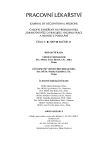Risk factors at work in the bakery
Authors:
J. Ticháčková 1; J. Chaloupka 2
Authors‘ workplace:
Zdravotní ústav se sídlem v Hradci Králové, územní pracoviště Trutnov
vedoucí pracoviště MUDr. Hana Řádová, Ph. D.
1; Klinika nemocí z povolání, Lékařská fakulta Univerzity Karlovy a Fakultní nemocnice
Hradec Králové, přednosta doc. MUDr. Jiří Chaloupka, CSc.
2
Published in:
Pracov. Lék., 61, 2009, No. 4, s. 176-181.
Category:
Original Papers
Overview
The baking industry is a significant field of food production. The paper summarizes risk factors of working environment in a particular bakery and describe the process of gaining background documents for the categorization of the work place. It presents a review of occupational diseases in food industry and particular cases of diseases developed at the work place under the supervision.
Employees of bakeries are exposed to a number of risk factors. The most significant is the exposure of rye and wheat flour – dusts with irritating and allergy causing effects. Warm environment, excessive load of muscle groups of upper extremities and work at night are other occupational risk factors. A systematic follow up of all factors of working environment and working conditions from the perspective of their negative impact on health of employees forms the basis for risk assessment in the working environment. Methods of measuring particular factors and criteria for evaluation of findings were developed for categorization of working positions. The dust load is categorized in relation to an acceptable exposure limit (AEL) which is defined according to the dust origin; the AEL value for flour dust for eight hours working shift is 4 mg/m3. Acceptable exposure limits exceeded the given norm during the first measurement. The measures were taken to lower the concentration of flour dust in the working environment in collaboration with an employer, organization of protection of public health, workers of laboratories of health institutes and physicians providing occupational medical services so that AEL is no more exceeded. Lowering concentrations of dust in working environment is a significant preventive measure with a positive impact on health of employees. The role of an occupational medical service in prevention of professional diseases is discussed.
Key words:
occuaptional medical care, flour dust, categorization, acceptable exposure limit
Sources
1. Zákon č. 258/2000 Sb., o ochraně veřejného zdraví, v platném znění.
2. Zákon č. 262/2006 Sb., v platném znění.
3. Nařízení vlády č. 361/2007 Sb., kterým se stanoví podmínky ochrany zdraví při práci.
4. Nařízení vlády č. 523/2002 Sb., kterým se mění nařízení vlády č. 178/2001 Sb., kterým se stanoví podmínky ochrany zdraví zaměstnanců při práci.
5. BRHEL, P., MANOUŠKOVÁ, M., HRNČÍŘ, E. et al. Pracovní lékařství. Základy primární pracovnělékařské péče. NCONZO Brno, 2005, 338 s. ISBN 80-7013-414-3.
6. Doporučení Společnosti pracovního lékařství ČLS JEP k pracovnělékařské péči/službě, dostupné na www.pracovni-lekarstvi.cz/files/doporuceni_SPL_k_PLS_2007-05-25.doc.
7. HNIZDO, E., SULLIVAN, P. A., MOON BANG, K. et al. Association between chronic obstructive pulmonary disease and employment by industry and occupation in the US population: a study of data from the Third National Health and Nutrition Examination Survey. Am. J. Epidemiol., 2002, č. 156, s. 738–746.
8. Koncepce oboru pracovní lékařství. Dostupné na: www.pracovni-lekarstvi.cz/files/koncepce.doc.
9. Registr nemocí z povolání. Dostupné na:
www.szu.cz/publikace/data/nemoci-z-povolani.
10. TUČEK, M., CIKRT, M., PELCLOVÁ, D. Pracovní lékařství pro praxi. Praha: Grada 2005, 344 s., ISBN: 80-247-0927-9.
Labels
Hygiene and epidemiology Hyperbaric medicine Occupational medicineArticle was published in
Occupational Medicine

2009 Issue 4
Most read in this issue
- Risk factors at work in the bakery
- Working positions – experience from the practice of physiological measurements
- Significance of measuring skin temperatures in diagnostics of the Raynaud syndrome from vibrations
- Noise as a risk factor in school facilities
